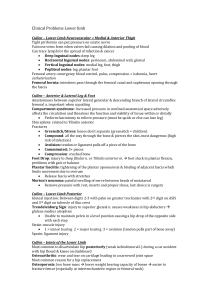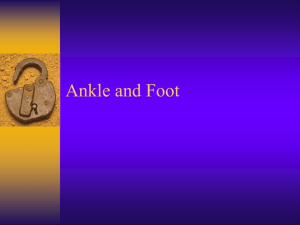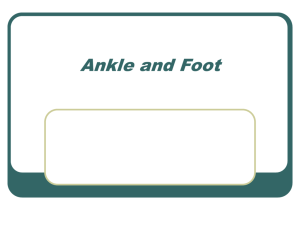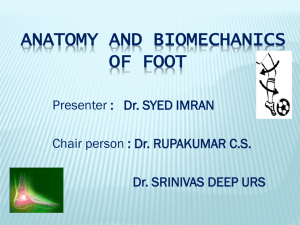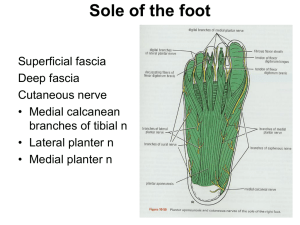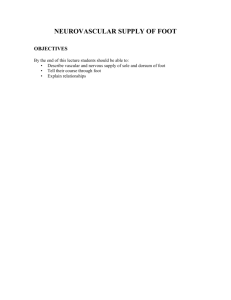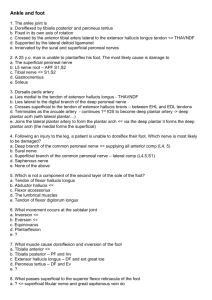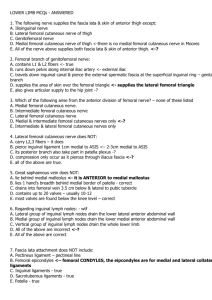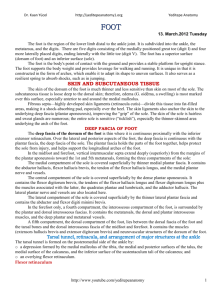If you need a leg to stand on, we`ve got your back…
advertisement
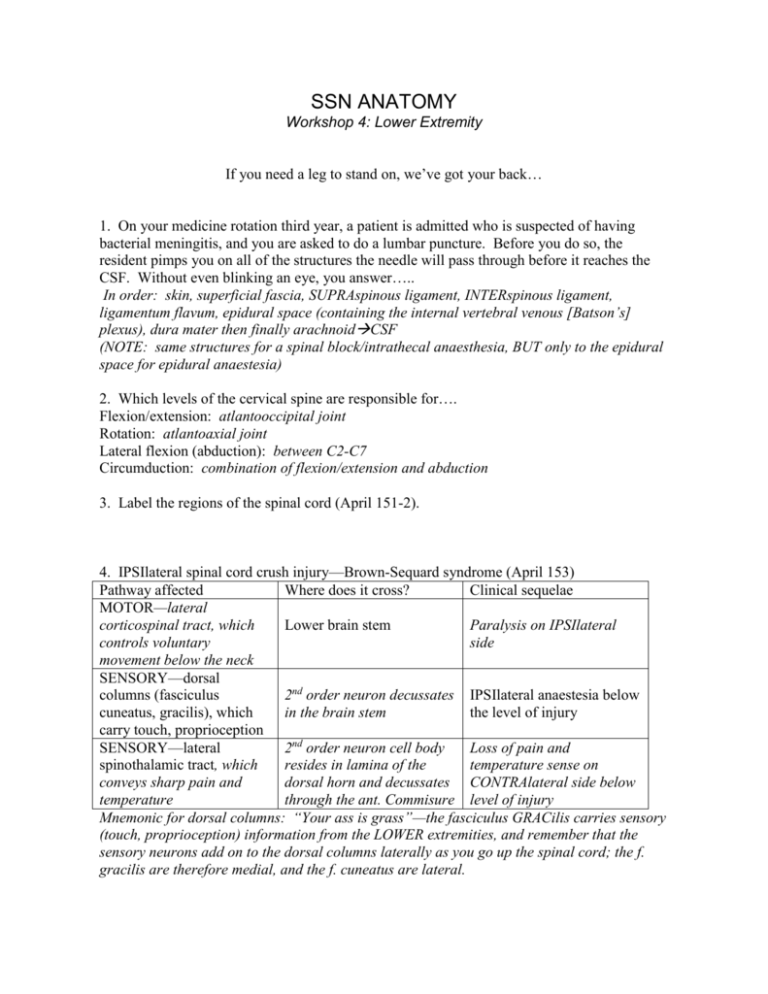
SSN ANATOMY Workshop 4: Lower Extremity If you need a leg to stand on, we’ve got your back… 1. On your medicine rotation third year, a patient is admitted who is suspected of having bacterial meningitis, and you are asked to do a lumbar puncture. Before you do so, the resident pimps you on all of the structures the needle will pass through before it reaches the CSF. Without even blinking an eye, you answer….. In order: skin, superficial fascia, SUPRAspinous ligament, INTERspinous ligament, ligamentum flavum, epidural space (containing the internal vertebral venous [Batson’s] plexus), dura mater then finally arachnoidCSF (NOTE: same structures for a spinal block/intrathecal anaesthesia, BUT only to the epidural space for epidural anaestesia) 2. Which levels of the cervical spine are responsible for…. Flexion/extension: atlantooccipital joint Rotation: atlantoaxial joint Lateral flexion (abduction): between C2-C7 Circumduction: combination of flexion/extension and abduction 3. Label the regions of the spinal cord (April 151-2). 4. IPSIlateral spinal cord crush injury—Brown-Sequard syndrome (April 153) Pathway affected Where does it cross? Clinical sequelae MOTOR—lateral corticospinal tract, which Lower brain stem Paralysis on IPSIlateral controls voluntary side movement below the neck SENSORY—dorsal columns (fasciculus 2nd order neuron decussates IPSIlateral anaestesia below cuneatus, gracilis), which in the brain stem the level of injury carry touch, proprioception SENSORY—lateral 2nd order neuron cell body Loss of pain and spinothalamic tract, which resides in lamina of the temperature sense on conveys sharp pain and dorsal horn and decussates CONTRAlateral side below temperature through the ant. Commisure level of injury Mnemonic for dorsal columns: “Your ass is grass”—the fasciculus GRACilis carries sensory (touch, proprioception) information from the LOWER extremities, and remember that the sensory neurons add on to the dorsal columns laterally as you go up the spinal cord; the f. gracilis are therefore medial, and the f. cuneatus are lateral. 5. What is the highest corresponding vertebral level of the iliac crests, and why is this clinically relevant? (April 149, 155, 472) L4—landmark for spinal tap/epidural and spinal anaestesia—the low level on the vertebral canal ensures that the spinal cord has already terminated inferiorly; also the spinous processes of the lumbar vertebrae are more horizontal, improving access to the vertebral canal. Remember that the vertebral column outgrows the spinal cord after the fourth fetal month, resulting in the cauda equina (“law of descent”—spinal nerves still emerge from corresponding level of vertebral column). 6. Where in the vertebral column is disc herniation most likely to occur? In which direction does the disk go, and what happens? (April 140) The L4-L5 and L5-S1 disks are most likely to herniate, and they do so POSTEROLATERALLY, where the annulus fibrosis is NOT reinforced by ligamentous or bony structures. The NEXT LOWER vertebral level spinal nerve is compressed (L5 or S1, respectively), causing symptoms (referred pain down buttocks, back of legs, etc.) related to the dermatome and myotome supplied by that nerve, as well as local pain from the stretched annulus fibrosis (painful spasms of back muscles). 7. What is the strongest joint in the body? What type of joint is it? Are there any changes this joint experiences throughout life? Name the five ligaments that support it. (April 163, 165) Sacroiliac joint—articulation of alar plate of sacrum with ilium. The SI joint is a diarthrosis (synovial joint); the joint usually fuses by age 50, and also the supportive ligaments become relatively lax in pregnancy. The five supportive ligaments are: dorsal SI ligaments, ventral SI ligaments, iliolumbar ligaments, sacrospinous ligament, sacrotuberous ligament. 8. What are the differences between intracapsular and extracapsular fractures of the hip joint? What are the capsular ligaments? Speaking of trauma, what is the most common type of dislocation of the hip joint? What nerve is at risk for injury? (April 164, 167) Intracapsular fractures (FEMORAL NECK) endanger blood supply to proximal fragment (the femoral head), resulting in AVN; extracapsular fractures are more likely to heal without problems, due to a more abundant collateral blood supply (medial and lateral circumflex arteries). Capsular ligaments are the iliofemoral (Y ligament of Bigelow), the ischiofemoral, and the pubofemoral ligaments. POSTERIOR dislocation is the most common—the hip joint is least stable in the flexed position, and dislocation can occur when the flexed thigh comes into violent contact with a dashboard for instance, placing the SCIATIC n at risk. The patient presents with the head of the femur posterior to the iliofemoral ligament and the lower limb is flexed at the hip joint, adducted, medially rotated, and shorter than the uninjured limb. 9. You are on your third year rotations and you happen to be in the ER. A patient comes in who needs a cannula inserted, and you are told to do so. You panic, being that you’ve never done one before, but then you remember your anatomy. Where is a good place to insert a cannula? Which nerve are you going to try really hard not to damage? (April 235, 239) Great saphenous vein, anterior to the medial malleolus. The saphenous nerve (terminal branch of the femoral n) can be damaged, causing pain on the medial side of the dorsal foot. 10. On same day, a patient comes in who is complaining of a pain and pin-prick sensation on his lateral thigh. The patient is a middle-aged man who is markedly obese. The intern didn’t go to P&S and therefore didn’t take Clinical Anatomy, and he’s too busy to find his copy of Netter, so he asks you what you think. What’s going on? (April 233) The lateral femoral cutaneous nerve (L2-3 off the lumbar plexus) is being pinched by the obese abdomen between the inguinal ligament and the iliopubic ramus. 11. What are the muscles that insert onto the greater trochanter of the femur? The lesser? Greater troch—piriformis, obturator internus and externus, superior and inferior gemelli (all lateral rotators of thigh), and gluteus medius and gluteus minimus muscles (aBductors of thigh) Lesser troch—iliopsoas muscle ONLY (major flexor of hip joint) 12. What are the SIX muscles that act across BOTH the hip and knee joints? SARTORIUS (hip and knee flexion) TENSOR FASCIA LATA (disconcerting sinking feeling—flexes hip and flexed knee, extends extended knee) GLUTEUS MAXIMUS (same as TFL since it inserts onto the fascia lata), GRACILIS (flexes hip and knee) RECTUS FEMORIS (flexes hip, extends knee) BICEPS FEMOIS—LONG HEAD (extends hip, flexes knee) 13. What are the boundaries of the femoral triangle? What are its contents? (April 192-3) Boundaries: inguinal ligament, sartorius muscle, and adductor longus muscle. Contains: femoral ring (which contains lymphatics that drain inguinal lymph nodes), femoral artery, nerve, and vein (NOTE: great saphenous vein joins femoral vien here—good spot for a saphenous cutdown) 14. What about the popliteal fossa and its contents? (April 195) Boundaries: superolaterally by the biceps femoris, superomedially by the semitendinosus, and inferiorly by the lateral and medial heads of the gastroc; the popliteal muscle forms the floor. Contains: tibial nerve, common peroneal nerve, popliteal artery (when femoral artery emerges from adductor canal into popliteal fossa, it is then the popliteal artery), popliteal vein, small saphenous vein 15. On your orthopedics rotation third year, you see an 18 yo patient who had broken his proximal fibula and lateral tibial condyle after a kick from an opponent in a karate match. He has healed the fractures, but is still walking abnormally—specifically, he has to “high-step,” meaning he raises his foot higher than normal so his toes don’t scrape the ground, and his foot makes a “clop” sound as it hits the floor. What is wrong? He probably damaged the common peroneal nerve as it swings around the neck of the fibula, and now has a foot drop. 16. What nerve…. Superior gluteal (L4-S1 posterior) Inferior gluteal (L5-S2 posterior) Femoral (L2-L4 posterior) Obturator (L2-L4 anterior) Tibial (L4-S3) Common peroneal/fibular (L4-S2) Innervates these muscles? What happens w/nerve damage? Gluteus medius and Abductor lurch minimus, Tensor fascia lata (Trendelenburg gait)—no ability to pull the ipsilateral pelvis down when walking; no abduction of thigh Gluteus maximus Inability to rise from a chair or climb stairs Iliacus, sartorius, 4 Weakened flexion of thigh, quadriceps femoris muscles, extension of leg is lost, and pectineus ALSO sensory loss over anterior thigh and medial leg and foot Adductors longus, brevis, Adduction of thigh lost, and anterior part of magnus, some sensory loss medial gracilis, pectineus thigh Posterior part of adductor Loss of plantar flexion and magnus, gastroc, soleus, flexion of toes, weakened plantaris, popliteus, flexors inversion of foot, sensory digitorum and hallucis loss on sole of foot, no longus, tibialis posterior, Achilles reflex; NOTE: Pt intrinsic muscles of plantar with tibial n. KO’d will foot present with calcneovalgocavus— opposing muscles dorsiflex and evert foot Short head of biceps Loss of eversion and femoris, peroneus dorsiflexion of foot, loss of longus/brevis/tertius, extension of toes (NOTE: extensor hallucius and FOOT DROP—Pt presents digitorum longus, tibialis in equinovarus—plantar anterior, intrinsic muscles flexion and inversion of of dorsal foot foot), and sensory loss over anterolateral leg and dorsal foot 17. The next patient you see on your orthopedics rotation is the running back for Columbia’s football team. He took a really hard hit in the knee in the homecoming game against Harvard, in which Columbia stomped over their opponent and made the alumni proud (obviously a fictional tale). Still, he insists that you watch the tape of the game he brought with him, and you see that his knee was flexed and his foot was planted as he was hit on the lateral side of the distal femur. You examine him and note that his knee locks, makes popping noises on movement, and cannot reach terminal extension, and he exhibits an anterior drawer sign but no posterior drawer sign. What do you think is going on here? (April 183-7) Based on the locking, popping, and the anterior drawer sign, he probably has the “unhappy/terrible triad”—medial meniscal tear, MCL and ACL tear/rupture, which can happen with violent abduction and lateral rotation of the semiflexed fixed leg. Remember that the medial meniscus is attached to the MCL, whereas the lateral meniscus is not attached to the lateral collateral ligament. Also remember that the medial meniscus is C shaped and the lateral meniscus is O-shaped. The medial meniscus is well-attached to the knee joint (via the short internal collateral and coronary ligaments), and has restricted movement, making it prone to tears. The lateral meniscus is relatively free to move (attached to the meniscofemoral and coronary ligaments)—it slides anteriorly with the lateral femoral condyle in the terminal phase of extension. Also remember the “finger-crossing” mnemonic for the orientation of the ACL and PCL in the knee joint. 18. What structures are contained within the flexor retinaculum (tarsal tunnel)? (April 215) From medial to lateral: tibialis posterior m., flexor digitorum m., posterior tibial artery and nerve, and flexor hallucius longus. Mnemonic: Tom Dick ANd Harry 19. What are the possible sequelae of a severe inversion of foot? (April 204) Inversion sprains, which can tear the lateral collateral ligaments, in increasing order of severity of the sprain: anterior talofibular ligament, calcaneofibular ligament, and posterior talofibular ligament. Also can end up with avulsion fractures, where the tuberosity of the fifth metatarsal (insertion of the peroneus brevis m) breaks off. 20. Reflex Cremasteric Patellar Hamstring (April 199) Achilles 21. Foot Musculature DORSAL Muscle Extensor digitorum brevis Extensor hallucius brevis Spinal level L2-L3 L2-L4 L5 S1 Muscle Group Cremaster Quadriceps femoris Hamstrings Posterior crural compartment Innervation Deep peroneal n., some superficial peroneal n. Deep peroneal n., some superficial peroneal n. PLANTAR It may be helpful to think of the dorsum of the foot having four LAYERS of muscles…. See plates 497-501 in Netter for diagrams. After removal of the plantar aponeurosis, getting DEEPER as you go, you have the… First layer Muscle Abductor hallucis (brevis) NOTE: no longus Flexor digitorum brevis Abductor digiti minimi Second layer TENDONS of flexor hallucis/digitorum longus mm. Lumbricals Quadratus plantae Third layer Flexor hallucis brevis (2 HEADS—med and lateral) Adductor hallucis (2 HEADS—transverse, oblique—shaped like a “7”) Flexor digiti minimi brevis Innervation Medial plantar n. Medial plantar n. Lateral plantar n. None—just the tendons Lateral plantar n. Lateral plantar n. Medial plantar n. Lateral plantar n. Lateral plantar n. Fourth layer Plantar interossei (three of them) Lateral plantar n. Dorsal interossei (four of them) Lateral plantar n. Mnemonic: Bring the plants IN in the winter—the plantar interossei ADDUCT the digits. 22. Mnemonic for lumbosacral plexus: 23. As you are finishing up your third year, you’re on your final rotation, pediatrics. You have been asked to give an IM injection in the gluteals to a screaming four-year-old with an equally anxious mother. Before you administer the shot, the mom asks you if there is a chance you will hit any nerves. You confidently shake your head no, and go on to explain to her that three of the four quadrants of the gluteal regions contain nerves which potentially could be damaged. Which is the safe quadrant and what are the nerves in the remaining three? (April 177) Superolateral quadrant—safe Inferolateral quadrant—inferior gluteal nerve Superomedial quadrant—superior gluteal nerve Inferomedial quadrant—sciatic nerve
